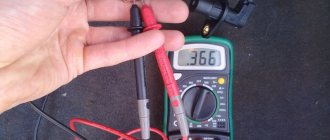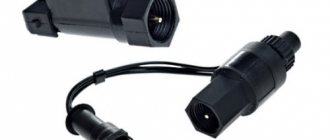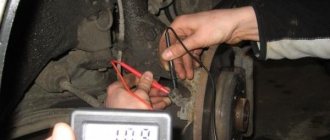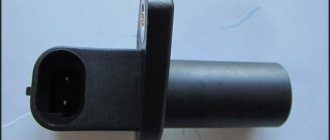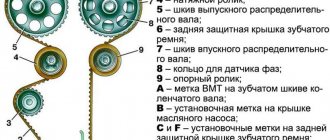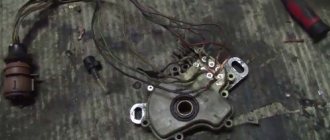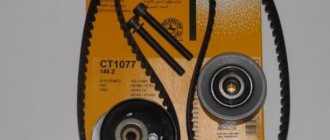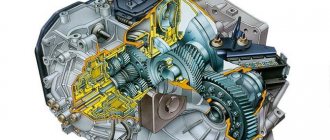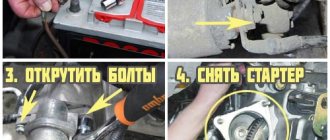DPKV (crankshaft position sensor), also known as TDC sensor (top dead center sensor) is the only sensor of the engine management system, if which breaks down, the engine will definitely not start. This sensor has no mechanical moving parts, so it rarely fails. Most often, corrosion-damaged wiring is to blame for its failure.
The device and where the crankshaft position sensor is located
The electrical sensor plays an important role in the proper operation of the power plant, so all car manufacturers place it within easy reach for inspection and repair. The DPKV is located on the right side of the engine, next to the flywheel in the area of the cylinder block. You need to look above the pan, closer to the starter and coolant outlet pipes.
Crankshaft position sensor location
It is usually secured with one or two bolts (depending on the modification) and has a small wire with a contact chip. The element is coated with an elastic polymer that is resistant to oils and high temperatures
DPKV position relative to the mark
The shaft position is determined by two missing teeth or a dedicated control one (depending on the type of flywheel). DPKV “notices” this visually and using electromechanical processes. There are three types of controller.
With Hall sensor
Works with a magnet mounted on the flywheel. Whenever it passes the sensor, a direct current is excited in the DPKV. This is recorded by the synchronizing disk and the information is transmitted to the engine control unit.
DPKV with Hall sensor
Optic
The device has an LED. Works in conjunction with a receiver. The beam always leaves and is reflected. When the glow is interrupted, it means that the control tooth has passed by the controller. It is used to determine the position of the crankshaft.
Optical DPKV
Inductive
Contains inside a magnetized coil that responds to an electromagnetic field. When the indicators change, a mark is recorded indicating the specific position of the pulley on the shaft.
Inductive DPKV
The last type is the most common and is installed on all modern cars with a fuel injection system into the engine. In addition to the position of the crankshaft, it is able to determine the rotation speed, therefore it is more functional.
What kind of service is this?
Modern cars are equipped with a computerized engine control system, the operation of which is based on collecting information from sensors and transmitting this data for processing by a computer. The crankshaft position sensor is used in conjunction with the camshaft position sensor to control ignition timing and provides information to the computer to calculate fuel injection timing and determine the spark sequence across the engine cylinders. Due to the location of this sensor in the engine, it usually fails due to overheating or engine oil contamination.
Sensor types
Depending on the principle of operation, DPKV are divided into:
- Optical. The principle of operation is as follows: the synchronization disk, which has special grooves or holes, interrupts the light beam between its source and receiver. The latter, having received the information, processes it and then sends it to the electronic control unit.
- Magnetic. Such sensors do not require an additional power source. The voltage necessary for operation is generated at the moment when the synchronizing tooth passes through the magnetic field generated around the sensor. In addition to their direct function, they are also used to measure speed.
- Based on the Hall effect. The sensor begins to operate when a changing magnetic field approaches it. The teeth of the synchronization disk get into it and begin to interact with it. This type of device is also used as an ignition distributor sensor.
Crankshaft position sensor: replacement and purpose
This device is almost the only sensor in the car, the failure of which leads to a complete stop. The fact is that its main task is to ensure the correct operation of the injectors and ignition system, so failure causes the entire fuel system to stop.
It is advisable to always have a spare sensor with you, even though it rarely fails. Replacing the DPKV is a simple procedure that can be completed within half an hour. This does not require disassembling the engine and removing the oil pan protection; you just need to remove the wheel.
If you don’t have the time, skills or spare parts, you can always turn to an experienced mechanic who will perform all the necessary operations in the shortest possible time. Replacing the camshaft sensor will ensure reliable operation of the engine control devices. Replacing the abs sensor is also an important detail that should not be overlooked.
Symptoms of a problem
To understand what signs of a malfunction may relate to the DPKV, let’s briefly consider its participation in engine operation. Asymmetrical projections on the crankshaft sequentially act on the connecting rods, pushing the pistons in the cylinders. The latter compress the air and pump up the compression. At the same time, the timing belt supplies the required amount of air to the cylinders through the cylinder head.
The engine control system “understands” the position of all participants, based on the DPCV data (provided that the timing drive is installed correctly), and opens the injectors to release gasoline. The ignition coils supply a spark to the spark plugs, and the air-fuel mixture ignites. The engine runs smoothly and does not jerk.
If the crankshaft sensor malfunctions, the synchronization of the process is disrupted. The engine ECU does not know at what point to supply gasoline, which affects the operation of the internal combustion engine.
Diagnostics will help you find the cause of the breakdown, but more on that below.
Among the signs of malfunction indicating a possible breakdown of the DPKV there are:
- the Check Engine icon lights up on the dashboard;
- loss of vehicle dynamics;
- unstable engine speed;
- the engine stalls spontaneously;
- detonation when pressing the accelerator pedal;
- The engine jerks and shakes.
If the crankshaft sensor fails completely, the engine cannot be started at all. But this can only be established by checking, where the diagnostics will show the condition of other participants in the ignition system.
Popular brands:
Hyundai Creta
The main symptoms of a malfunctioning crankshaft position sensor
The crankshaft device is a complex system, all parts of which must always be well lubricated. If the gaps between the bearings increase over time, or poor quality engine oil is used, the crankshaft parts will not be properly lubricated. As a result, damage may occur. In order to determine problems with the crankshaft, it is necessary to perform several checks, such as: check the crankshaft liners, oil seals, journals, etc. There may be several problems associated with the crankshaft:
- The gap between the crankshaft and the liner increases;
- The opening in the bearing increases as a result of a broken crankshaft journal (scuffed journal);
- The surface of internal parts wears out, cracks and scratches form;
- The crankshaft liners overheat or melt;
- The key is cut;
- The crankshaft flange holes intended for mounting the flywheel wear out;
- The crankshaft sensor breaks.
To eliminate the above breakdowns, the entire motor is usually removed. It is worth noting that it is possible to remove the crankshaft without removing the engine, however, many consider this procedure much more complicated and resort to the standard repair method. As for the symptoms of a malfunctioning crankshaft sensor, these include the following:
- the car's power drops sharply;
- revolutions can increase and decrease arbitrarily without control;
- detonation occurs under heavy load on the engine;
- when you turn the key, the engine may not start;
- When idling, the engine operates unstably, lowering and increasing speed on its own,
- or there may be no idle at all.
Verification methods
The symptoms described above may be signs of a malfunction of more than just the crankshaft sensor. Such symptoms also apply to spark plugs, displaced marks in the timing belt assembly, high-voltage wires, and ignition coil. Here it is important to know how to test the controller.
Checking the DPKV will help make sure that the fault is in it, and not in a skipped timing belt or a dirty engine throttle valve.
There are several diagnostic methods. Since most DPKVs are inductive, we will consider testing just such a controller on the shaft.
wrench
If the engine does not start and there are no measuring instruments or service stations nearby, you can check the position sensor with a wrench. For this method it is good to have a second person as an assistant:
- Open the hood and unscrew the sensor fixing bolt.
- Take the DPKV out and clean it of dirt.
- Turn on the ignition.
- Remove the cushion on the second row of seats so that you can better hear the operation of the fuel pump in the tank.
- Without removing the contact chip, apply a wrench to the end of the sensor.
- The second person should at this moment hear the fuel pump turning on.
This key test triggers the induction coil and simulates the passage of a pulley. If the fuel pump turns on every time a metal object is applied, then the controller responds to the position of the shaft. If the pump is not heard, then the symptom will definitely indicate a breakdown.
Oscilloscope
Checking the crankshaft sensor with an oscilloscope is done in two ways and gives a more accurate idea of the controller's response to the position of the shaft. In the first case, the action occurs with the engine turned off, but with the ignition on.
The sensor is removed from its place, and oscilloscope probes are applied to its contacts. Polarity doesn't matter here. Next, a metal object is passed in front of the end part of the sensor (you can use the same wrench). The coil should fire on metal, but instead of removing the back seat and listening to the sound of the fuel pump, the response will be visible on the oscilloscope screen.
Checking DPKV with an oscilloscope
A more accurate test can be performed with the engine running by connecting an oscilloscope parallel to the DPKV terminals. Then the program will show not only the reaction, but also a complete picture of the controller’s operation. The amplitude of the electromagnetic field will be displayed on the screen. It should have even upper and lower boundaries, as well as equal separation intervals indicating the passage of the control section. If there are more such pauses or the edges of the oscillogram are not smooth, it means that some of the flywheel’s teeth are broken off or severely worn out. This leads to incorrect sensor response. Then the issue is not a malfunction of the crankshaft sensor, but a mechanical part. The flywheel crown will need to be replaced.
Multimeter
Checking the crankshaft sensor with a multimeter is performed in resistance measurement mode. To do this, the step switch is set to the appropriate position. The DPKV is removed outward, and the multimeter probes are inserted into the contacts.
Checking the sensor with a multimeter
Most sensors have a coil resistance range of 500-700 Ohms (you can find out more precisely from the characteristics of a specific model and the manufacturer’s data). Therefore, the device must be set to the upper value of 2000 Ohms. If the tester shows lower values, then the insulation of the coil winding is damaged. Such a malfunction requires replacement of the sensor. The absence of readings on the tester means that the circuit is broken and the DPKV is unsuitable for use.
In addition to resistance, some multimeters can test inductance. For the crankshaft position sensor, this indicator should be 200-400 mH. A significant deviation from the specified range indicates a controller malfunction.
Diagnostic scanner
Those who take a more professional approach to repairing their car have a diagnostic scanner in their tool kit. It helps to check not only the sensor, but also other parameters of the gasoline engine. Among products of Korean origin, OBD-2 Scan Tool Pro scanners are very popular.
Diagnostic scanner
The device is inserted into the car's standard connector and communicates with the ECU. Using a laptop, phone or PC, pairing occurs via Bluetooth or Wi-Fi network. A special program will be required. Collected errors are displayed on the screen. Among the fault codes related to the crankshaft position sensor: P0336 and P0335. Checking with a scanner consists of the presence of a signal from the position sensor and the ability to determine the reference mark to synchronize the subsequent operation of the engine.
Checking with an ohmmeter
If you don’t have a multimeter at hand, but have an ohmmeter, then that will also work. With the engine off, you will need to remove the crankshaft electric sensor and touch the device leads to the contacts in the connector. The operating parameters of the DPKV should be in the range of 500-700 Ohms. If the resistance is very high, then somewhere there is interference with the passage of electric current. If the indicator is too low, the integrity of the winding is compromised.
Our recommendations
- Replacing the DPKV requires serious monitoring of the gap between the synchronization disk and the core.
- Before removing the device, draw special marks on the body and bolts - this will help with ease of reassembly.
- Installation of the sensor is carried out in exactly the reverse order.
Crankshaft position sensor
Crankshaft position sensor location diagram
Crankshaft position sensor in a car
Trouble-shooting
The check may show the inability of the electric sensor to detect the condition of the crankshaft. In this case, if the failure of the DPKV is confirmed, it will need to be replaced with a new one. But if the breakdown happened on the road and the nearest car shop or service station is far away, you can try to find and fix the problem yourself. Sometimes the problem lies not in the coil of the induction device, but in the contacts.
Cleaning from dirt
For example, a common problem is contamination of the working part with grease from the flywheel. The latter flies onto the sensor and covers it with a thick layer of dirt. Dust and sand, as well as metal shavings, stick to the top. All this creates interference with the operation of the element. In this case, you will need to unscrew one or two holding bolts, remove the DPKV out and thoroughly wipe its body protruding after the stop. Then return the device back and try to start the engine again.
Dirty PCV sensor
Broken contact
Another common problem is a broken wire. It often happens before the contact chip. At this point the wires bend, which leads to gradual refraction. Visually, a violation of the integrity of the conductor may not be noticeable, since the outer insulation remains intact.
To resolve the problem, remove the connector and pull the contact pins lightly towards you. The tattered one will come out and remain in your hands.
Repairs will require stripping the insulation and tying off the exposed ends. Then the area is insulated (you can use cambric or electrical tape). But this measure is temporary and will require subsequent soldering.
Contact contamination
Although the connector is protected by a rubber seal, it gradually loses elasticity and tightness. Because of this, moisture and dust penetrate inside. The corrosion process begins. The contacts oxidize and the circuit is interrupted. As a result, a serviceable DPKV ceases to detect the condition of the crankshaft and the engine stalls.
Dirt on DPKV contacts
To solve the problem, try cleaning the contact pins. They are located in the recesses and can be reached with a thin file or sandpaper rolled into a tube. Blow out any dust that has accumulated inside, restore the connection and try to start the engine.
Related Issues
If the DPKV “rings” and there is no violation in the integrity of the contacts, the breakdown may be associated with missing teeth on the flywheel. The electric sensor simply “confuses” the ECU, responding to additional “tags” formed. Only a mechanic at a service station can determine this. To repair, you will need to replace the flywheel crown.
The MAF (determines the mass air flow) also affects the operation of the DPKV and causes deviations in the readings. The problem is diagnosed in the service.
A figure-eight bend of the flywheel can mislead the crankshaft electric sensor, and this will require removing the box and replacing the deformed part.
